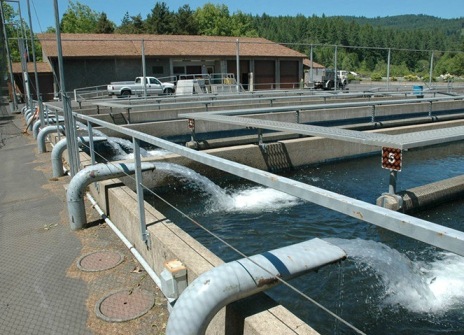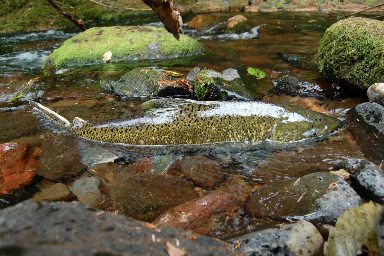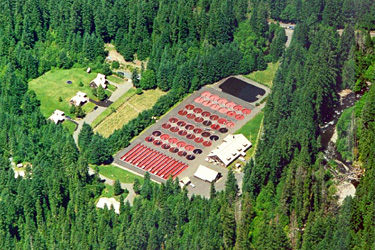Willamette Hatchery Research



Goals and Objectives
The ultimate goal of ODFW’s Hatchery Research, Monitoring and Evaluation (HRME) program is to inform decisions on operation of the USACE Willamette Valley Hatchery Mitigation Program so that mitigation goals are met while minimizing negative impacts on naturally-produced, listed species and promoting their conservation and recovery (Peven and Keefe 2010). Progress towards that goal will follow achievement of three overarching objectives:
- Develop and maintain hatchery broodstocks to meet mitigation, conservation, and recovery goals, and comply with existing genetic guidelines (Hatchery Genetic Management Plans);
- Rear and release high quality hatchery fish to minimize impacts on naturally produced fish and promote conservation and recovery of listed species;
- Manage adult returns to minimize impacts on naturally produced populations and to aid in recovery goals.
Our intent is to measure progress towards achieving those objectives by performing a combination of tasks that include “Baseline Monitoring” (work that is performed annually) and “Uncertainty Research” (work associated with specific, relatively short-term research projects).
Baseline Monitoring Tasks for Willamette Valley Hatchery Fish
The baseline monitoring tasks include:
- Spawner surveys in the upper Willamette sub-basins. These surveys provide estimates of spawner abundance, type (hatchery or wild), distribution (both temporal and spatial), diversity, and productivity as well as direct estimates of prespawning mortality. The surveys are conducted above and below project dams. Work in the river reaches below project dams is important because those reaches experience the largest potential impacts of returning adult hatchery fish. Work in the reaches above project dams is important because the “outplanting” of a mixture of hatchery- and natural-origin adults above project dams is intended to achieve the recovery of the listed species in their historical habitats. Surveys are essentially censuses in time and space because we start early (July), end late (October/November) and cover almost all of the spawning reaches but the estimates are based on a peak count expansion with its associated large and unknowable uncertainty.
- Operation of fish counting stations. Video monitoring of migrating adult fish on the North Santiam (two stations: upper and lower Bennett Dams) and the McKenzie (Leaburg Dam) permits direct and “fish-friendly” estimates of species composition, stock composition, run size and run timing.
- Biological sampling of adult fish at hatcheries and traps. This task incorporates two subtasks where (1) broodstock being incorporated into hatchery programs are sampled to obtain estimates of diversity (origin, size, age structure, run timing, spawn timing) and (2) during “Outplanting” operations (see Task 1, above) which occurs coincident with acquisition of fish for broodstock, tribal cultural use, sales, and donation to charities.
- Biological sampling of juvenile fish at hatcheries and traps. This task involves monitoring of fish performance both in-hatchery (survival, growth) and post-release (migratory performance). Juvenile sampling of naturally-produced fish, generally those produced above USACE dams but increasingly including sampling of fish in mainstem reaches also occurs and that effort is expanding. Not specifically part of Hatchery RME but we collaborate and share resources.
- Analysis of biological data and specimens including scales, otoliths, genetic samples, and mark and tag recovery information from hatchery fish. A variety of marking (fin clipping, otolith thermal marking) and tagging (Coded Wire Tags, Blank Wire Tags, Floy tags) techniques are routinely used to track performance of hatchery fish after release. Analysis of scale samples for investigating life history attributes of fish and otoliths for investigating both life history attributes and hatchery vs. wild origin of fish represents an integral portion of Hatchery Research Monitoring and Evaluation activities. Genetic sampling permits estimates of relative reproductive success of hatchery and wild fish and descriptions of patterns of genetic diversity across the subbasins. Collectively, the work is intended to assure that Willamette hatchery fish can be, for example identified during and apportioned among fisheries and during spawning surveys and hatchery sampling (described above) and increase our understanding of how hatchery- and wild-origin fish interact.
Uncertainty Research Tasks for Willamette Hatchery Fish
“Uncertainty Research” tasks represent special circumstances where research questions addressing particular uncertainties associated with achieving conservation and recovery goals are identified and prioritized through a formal process described in detail in the Willamette Biological Opinion (NOAA 2008). These tasks generally involve a marking regimen in hatcheries using a variety of tagging options (Coded Wire Tags, Passive Integrated Transponder tags, radio tags, acoustic tags, genetic marks, unique fin clips, etc.) followed by tracking and recovery of the tags over time and space to associate a particular experimental procedure with some metric of performance. The research tasks that are being accomplished now by ODFW or are likely to be included in our research program into the near future, based on the formal review process that occurred in 2011, include:
- Evaluating the integration of natural-origin fish into hatchery programs.
- Evaluating the effect of size and time of release of hatchery fish on outmigration, smolt to adult return rates, adult age structure and adult sex ratios.
- Evaluating survival and reproductive performance of outplanted hatchery- and natural-origin adult fish.
- Evaluating effect of rearing practices at hatcheries (e.g. rearing density) on smolt-to-adult return rates.
- Evaluating potential for genetic and ecological interactions between natural- and hatchery-origin fish (e.g. hatchery summer-run and wild winter-run steelhead at juvenile and adult life history stages).
- Evaluating effect of juvenile planting strategies (e.g. direct release vs. scattered release) on spatial and temporal distribution of adult returns.
Other research by, for example, university researchers (OSU, UI) and consulting firms (e.g. Normandeau, R2) is prioritized and approved through the same process and funded by the USACE.